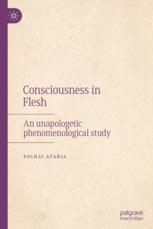We cannot reduce consciousness1 solely to brain activity and we cannot limit consciousness to the head. Consciousness is embedded in the world through the body: we are present in the world in our physical, visceral bodies; first and foremost, we are flesh and blood. Consciousness is not an exception; namely, consciousness is in the midst of the world from the very outset—conscious- ness and world are part of the same flesh. In this chapter, I will discuss ideas that contradict the classical approach to cognitive sciences, including: (1) The difficulty with the classic cognitive model, known as the sandwich model: input—information processing—output. I will attempt, instead, to delineate more dynamic cognitive models. (2) Objections to the subject-object dichotomy, instead seeking to redefine these relationships with greater flexibility. (3) Objections to the classic representational approach, which includes adopting a centralized computing model in the cognitive sciences in gen- eral, and in cognitive neuroscience in particular. Instead, I present cogni- tive models that treat the world as our best model, without the need for a central processing unit in the brain. (4) Objections to the approach that ignores the body in the framework of the cognitive sciences in general, and in cognitive neuroscience in particular. By contrast, I present cognitive models that are embedded within the body, which, in turn, is totally immersed within the world—cognition in flesh
چکیده فارسی
ما نمیتوانیم هوشیاری1 را صرفاً به فعالیت مغز کاهش دهیم و نمیتوانیم هوشیاری را به سر محدود کنیم. آگاهی از طریق بدن در جهان تعبیه شده است: ما در بدن فیزیکی و احشایی خود در جهان حضور داریم. اول از همه، ما گوشت و خون هستیم. آگاهی از این قاعده مستثنی نیست. یعنی آگاهی از همان ابتدا در میان جهان است - آگاهی و جهان بخشی از یک جسم هستند. در این فصل، ایدههایی را که با رویکرد کلاسیک علوم شناختی در تضاد هستند، بحث خواهم کرد، از جمله: (1) مشکل با مدل شناختی کلاسیک، که به عنوان مدل ساندویچی شناخته میشود: ورودی – پردازش اطلاعات – خروجی. در عوض، سعی خواهم کرد مدلهای شناختی پویاتری را ترسیم کنم. (2) اعتراض به دوگانگی سوژه-ابژه، در عوض به دنبال بازتعریف این روابط با انعطاف بیشتر است. (3) اعتراض به رویکرد بازنمایی کلاسیک، که شامل اتخاذ یک مدل محاسبات متمرکز در علوم شناختی به طور کلی، و در علوم اعصاب شناختی به طور خاص است. در عوض، من مدلهای شناختی را ارائه میکنم که با جهان به عنوان بهترین مدل رفتار میکنند، بدون نیاز به واحد پردازش مرکزی در مغز. (4) اعتراض به رویکردی که بدن را در چارچوب علوم شناختی به طور کلی، و در علوم اعصاب شناختی به طور خاص نادیده می گیرد. در مقابل، من مدلهای شناختی را ارائه میدهم که در بدن تعبیه شدهاند، که به نوبه خود، کاملاً در جهان غوطه ور است - شناخت در گوشت
ادامه ...
بستن ...
2 In the first section of this chapter, I examine in detail Merleau-Ponty’s phe- nomenological approach, in particular the notion that “the theory of the body is already a theory of perception” (Merleau-Ponty 2012, p. 209). The second section extends the discussion, offering a general theory regarding how we perceive the world through the body, focusing mainly on the sensorimotor feedback loops and the concept of knowing how. The final section explores the boundaries of our cognition, presenting the idea that cognitive activity leaks through the lived body into the world: First, I will discuss how various tech- nologies reshape the boundaries of the lived body, leading to a change in the I-Can field. Subsequently, I will concentrate on how we build robots without a central system. In the third part of this section, we will explore metaphors, in particular how they emerge from our bodily presence in the world. I will close this section by calling upon readers to keep their minds open—to allow the cognitive system to leak out into the world and the world to pene- trate inside. 1.1 The Phenomenology of the Body According to Merleau-Ponty If the subject is in a situation, or even if the subject is nothing other than a pos- sibility of situations, this is because he only achieves his ipseity by actually being a body and by entering into the world through this body. If I find, while reflect- ing upon the essence of the body, that it is tied to the essence of the world, this is because my existence as subjectivity is identical with my existence as a body and with the existence of the world, and because, ultimately, the subject that I am, understood concretely, is inseparable from this particular body and from this particular world. The ontological world and body that we uncover at the core of the subject are not the world and the body as ideas; rather, they are the world itself condensed into a comprehensive hold and the body itself as a knowing-body (Merleau-Ponty 2012, p. 431). 1.1.1 Return to the Primary Meeting with the World Phenomenology, as Merleau-Ponty wrote at the beginning of his monumental book, Phenomenology of Perception, first published in 1945, is the attempt to probe and to understand the essence of our existence before reflection took control of our lives and shaped how we understand human existence. For Merleau-Ponty, phenomenology is pre-reflective, an attempt to describe human experience, yet not from the viewpoint of judgmental consciousness:
ادامه ...
بستن ...










